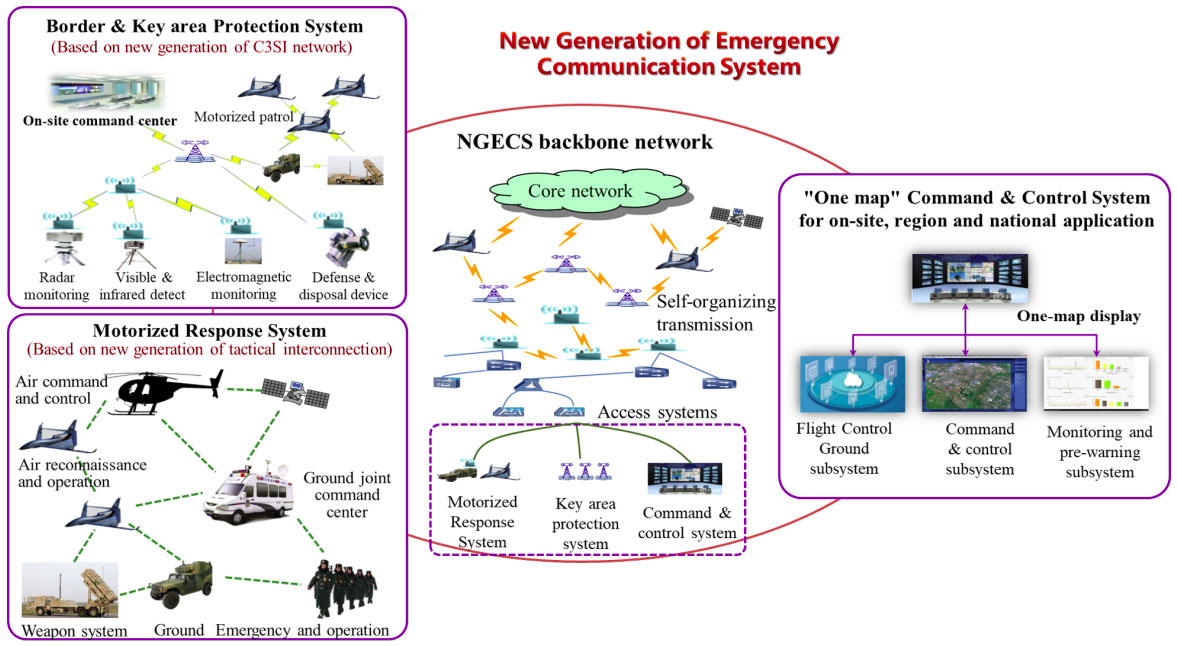System Introduction:
Aiming at the requirements of post-war reconstruction, emergency response, national resources and key area monitoring, on the technical basis of air-ground integrated backbone network, multi-physical domains detection and disposal measures (such as acoustic, optical, electrical, magnetic and mechanical domains), special vehicles and air motorized platforms (AMPs), a New Generation Emergency Communication System (NGECS) is built, characterized by multi-dimensional monitoring, wide-area interconnection and motorized response. The system integrates features of swift deployment, rapid reconstruction, anti-destruction, fault tolerance, and continuous evolution.
System Characteristics:
The NGECS is advanced and securer. Its prominent characteristics are as follows:
(1) Rapid deployment, simultaneity of construction and application, and continuous evolution.
The construction mode of all wireless backbone network is adopted to quickly cover the main resources, channels, borders and other important areas, so as to meet the real-time communication and information exchange needs of social security and emergency response. Meanwhile, through the heterogeneous integration of multiple network systems, a national network system with advanced techniques and complete functions will be formed.
(2) Air-ground, three-dimensional monitoring and control.
Through the interconnection of various spatial nodes and platforms, such as fixed ground station, AMP communication relay station, satellite communication station, mobilevehicle relay station, handheld terminal, etc., the air-ground integrated network combining fixed andmobileproperties is realized. At the same time, through the integration and linkage of airborne, vehicle, surface, underground and other sensing devices, rejection devices, themonitoring and control system based on the three-dimensional network is realized.
(3) Intelligent analysis and rapid response capability for resource protection and controlling.
The system provides multi-physical domain sensing devices and the capability of information detection, information transmission, intelligent information process.By means of intelligent pre-warning, remote control and motorized responsemechanisms, emergency services dealing with abnormal situations can be provided.
(4) Security, reliability, and robustness.
Through multi-dimensional security mechanisms, multi-level security protection including information access, transmission and application, can be realized.Meanwile, multi-level authentication and encryption is employed in the system. The cooperative andself-adaptivenetwork communication technique, whichprovides advantagesof survivability and self-healing, gives the overall system a higher adaptability to external damages. In the case of system node or link failure, the network can still heal itself automatically and operate effectively.
Furthermore, multiple frequency arepre-planned in the NGECSto avoid the same frequency interference and near frequency interference. Multiple channels are dividedand the channel with the highest quality is dynamicallyselected for the communication transmission. By using the technique of wireless modulation and demodulation with strong anti-interference ability, the robustness of NGECS is fundamentally improved. Additionally, spatial spectrum detection and suppress technique is adopted to discoverand timely remove wireless interference sources.
(5) Versatility integration for public and private applications.
Various security applications are maintained in the same physical network. By using advancedtechniques likenetwork virtualization and network resource slicing, virtual logic networks for private application in regular monitoring and government services, etc., are generated under the framework of the overall physical network.
